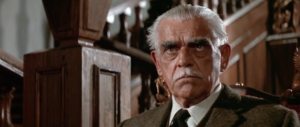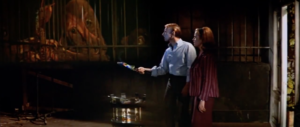1965’s Die, Monster, Die! is a loose adaptation of H.P. Lovecraft’s The Colour Out of Space. As an adaptation, it may disappoint fans of Lovecraft; but for fans of Boris Karloff, American International Pictures, and Hammer-style horror, Die, Monster, Die! has much to enjoy.
American Stephen Reinhart (Nick Adams) arrives in the quiet English village of Arkham to visit Susan Witley (Suzan Farmer), but none of the locals will dare go near the Witley mansion. Finding his own way there, Stephen meets Susan’s father, Nahum Witley (Boris Karloff), who insists that he must leave. However, Susan’s mother, Letitia Witley (Freda Jackson), alerts Stephen that something is going on, and that he must get Susan away immediately. The strange atmosphere in the house prompts Stephen’s curiosity, as does the haunting cloaked figure stalking the mansion grounds. In the basement, Nahum has dug up a meteorite which had crashed nearby; and its strange powers (radiation) are beginning to mutate everything – and everyone – nearby…
This is a perfect choice of horror picture to watch around the Halloween season. It borrows many aesthetic elements recognisable in Hammer Films’ best works; from copious amounts of fog, to the architecture of the film’s mansion, and, of course, the English village setting. Indeed, the inclusion of Boris Karloff instantly affords the film an air of horror authenticity.
Nick Adams appears as something of an anachronism; his character, a modern American, sits at odds with the English village setting. Moreover, on an extra-textual level, his appearing in a film more akin to Hammer’s works seems surprising after his brilliant turns in Toho’s sci-fi spectacles Invasion of Astro-Monster and Frankenstein Conquers the World – both released the same year as Die, Monster, Die! Of course, this is not a bad thing, and, in fact, it immeasurably adds to the enjoyment. As in the two aforementioned Toho pictures, Adams is charismatic and likeable; and seeing him in such a different kind of genre picture is rather exciting.

Boris Karloff gives a wonderful performance (when did he not?) as the patriarch of the Witley family. Karloff delivers many-a melodramatic line with gusto and malevolence.
Through Karloff, the film touches on ideas of past sins being repeated. Much is made of Nahum’s father, Corbin Witley, who is suggested to have called upon occult powers to bring the meteorite down from the heavens. Furthermore, there is, in Nick Adam’s closing lines, a brief comment on the responsibility of science. As radiation (and specifically uranium) is used to explain away the meteorite’s powers, it’s possible that comments on scientific responsibility are tied to ideas of atomic weaponry. Indeed, as the atomic bomb has been described in religious terms – most famously by J. Robert Oppenheimer himself – the idea of occult powers summoning the meteor fosters this connection, even if the perfunctory explanation of radiation seems like a cheap way to tap into contemporary fears. However, as so little is made of these ideas in the script, this reading is precarious.
The film sometimes suffers from a slow pace, and you’ll end up counting the number of times a character walks through the large mansion. Sometimes, these moments add a flare of character, as long shadows are cast over the old furniture. On other occasions however, the lighting is too flat to be noteworthy, and so one goes back to focusing on how long we’ve been watching Nick Adams walk from room to room.
Speaking of the mansion, the film seems to have been shot mostly with very wide lenses; the image often warps at the edges of the frame which, intentional or otherwise, adds a nice visual touch to the idea that life is being corrupted by the power of the meteorite in Nahum’s basement.

Of the mutations caused by the meteorite’s power, one particular scene stands out. Stephen and Susan explore Nahum’s greenhouse, finding overgrown vegetation. After hearing a monstrous scream that they’ve both heard before, the pair venture into the potting shed to find its source. Inside, they find several grotesque mutations; lumps of creeping flesh with eyes staring out at you. This is the film’s most Lovecraftian scene, as these creatures truly defy description. They somewhat call to mind the final form of the doomed astronaut in Hammer’s The Quatermass Xperiment (1955). As memorable as the scene is, it sadly doesn’t last very long; and we never get to see the creatures again.
However, fear not monster fans, for the film’s finale features Karloff himself succumbing to the meteorite’s powers; and the image of a mutated Nahum stumbling about the mansion satisfies the desire to see the film’s monster.
Despite some minor flaws, Die, Monster, Die! is a very entertaining horror film. Boris Karloff and Nick Adams are very watchable, and the film’s spooky atmosphere gifts it a degree of comfort; you can sink into the eerie mood, the creepy setting, and the strange monsters as though enjoying a ghost story around a crackling fire. Recommended.
